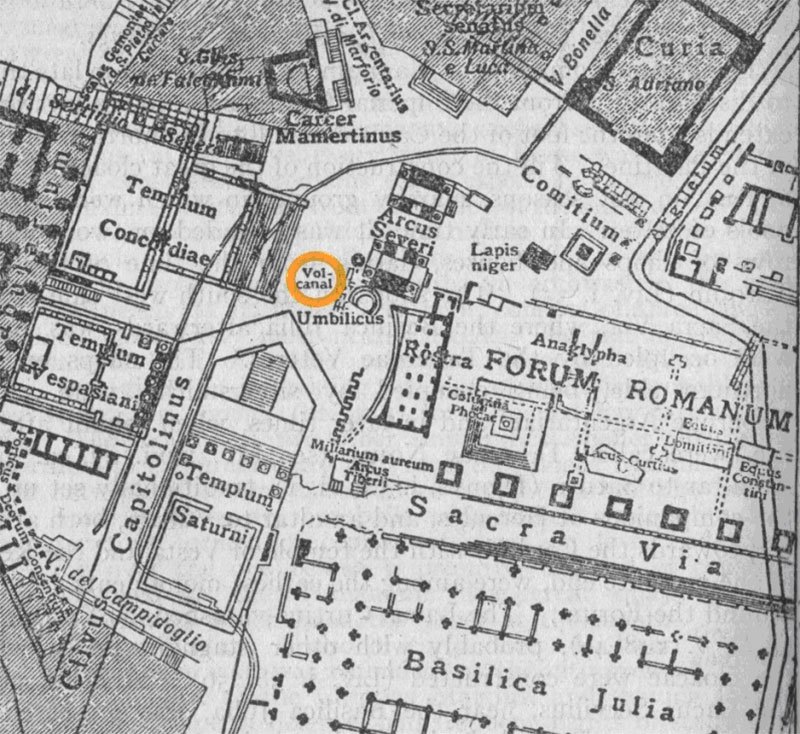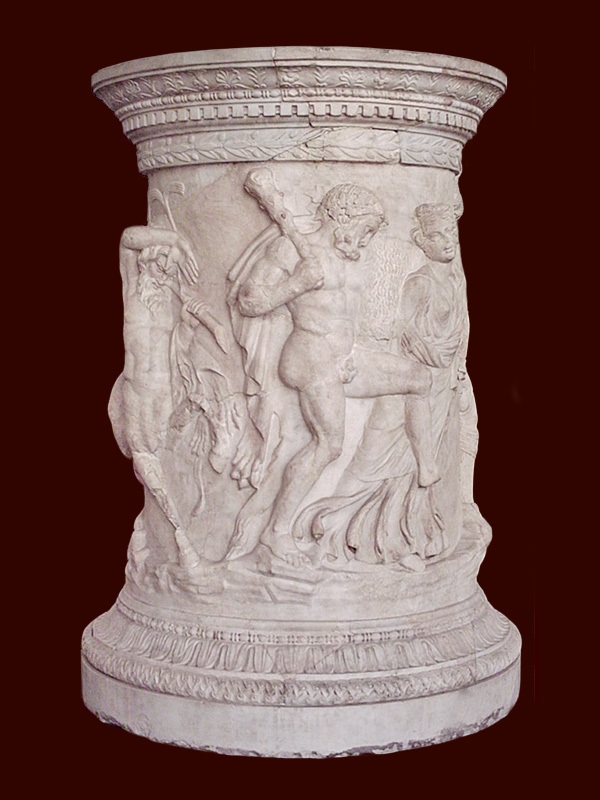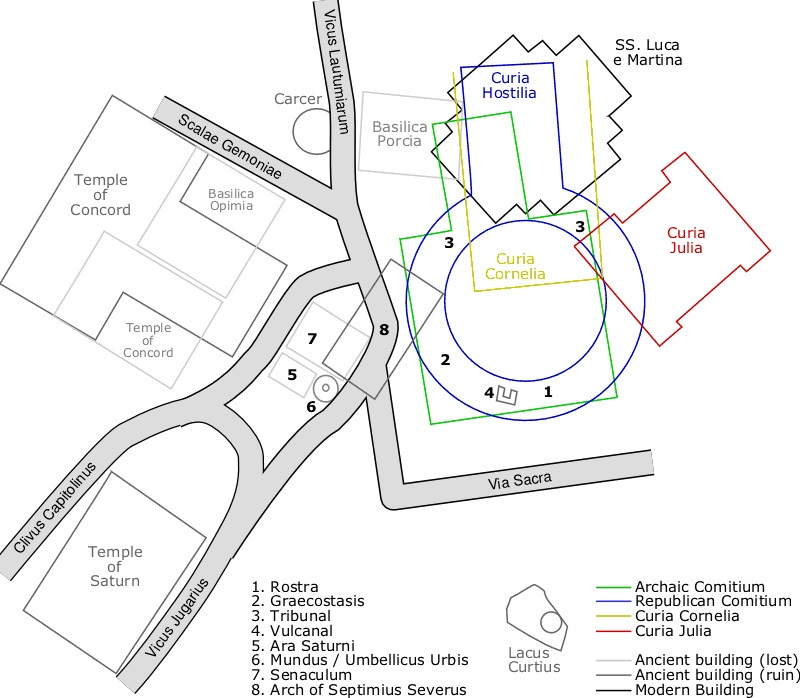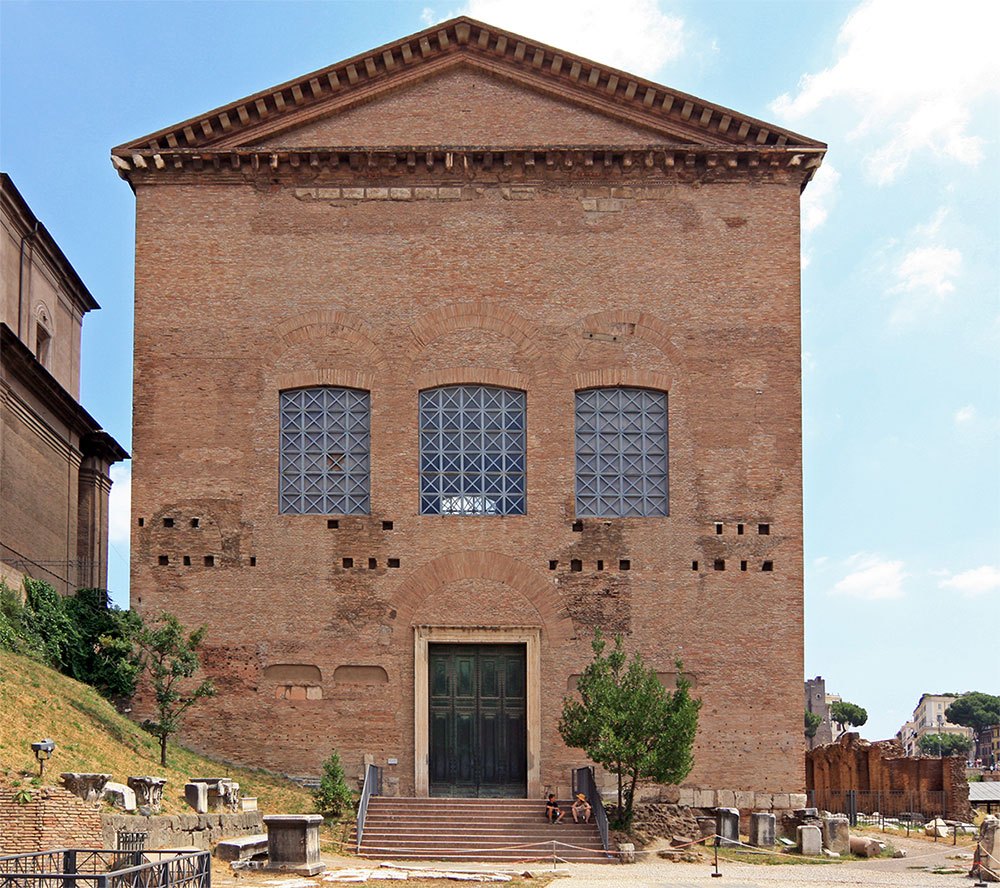Roman Building Projects
A Marker of Social Organization and Military Success
Archaic Rome
Comitium (Lapis Niger, Rostra Vetera, Tribunal)
Vulcanal (Before the Comitium)
- Vulcanal (Shrine of Vulcan) open-air altar (8th century BC); commemorates the spot where Romulus and Tatius concluded a peace treaty between the Romans and Sabines; served as a speaker’s platform before the building of the Comitium and the old Rostra
Lapis Niger
- The Black Stone (Lapis Niger) was erected sometime between 570-550 BC
- The Comitium, at this time, was thought to be a rectangular space, a templum, aligned with the cardinal points
- The Curia Hostilia was installed on the north side of the Comitium.
Tribunal
- The first speaker’s platform is constructed (circa 500 BC), the beginning of the Republic
- In the 5th century, the Law of the Twelve Tables was published on this platform
Ficus Ruminalis
- The Ficus Ruminalis was a wild fig tree that had religious and mythic meaning. It was originally located near the cave known as the Lupercal, where Romulus and Remus were suckled by a she wolf. The tree was sacred to Rumina, the goddess that protected breastfeeding mothers; animal and human. She was a very ancient goddess, rather abstract. The tree had palladium qualities.
Ficus Navia
- The Ficus Navia was a wild fig tree in the Comitium that was named for Attus Navius, an augur who experienced a miracle
- There was a statue of Navius nearby, in front of the Curia Hostilia. This fig tree was believed to have grown on a spot that was struck by lightning
- The tree also made reference to the Ficus Ruminalis which was on the other side of the Palatine Hill. The Ficus Navia was a palladium; it was considered sacred and related to the wellbeing of Rome. It died in 58 AD, but then set forth new shoots
Saeculum Romuli
- The Saeculum Romuli was the place where Romulus was either murdered or where he ascended to heaven
A Well in the Comitium
- Spot in the Comitium that was struck by lightning. It was marked by a wellhead under which were a razor and whetstone of Attus Navius, an augur. His statue stood nearby.
Statue of Attus Navius
- Was a bronze statue celebrating a miracle by which Navius, clothed as a priest, cut a whetstone with a razor
- Navius was an augur who opposed his king, Tarquinius Priscus, from taking a political action (increasing equestrian centuries) without religious sanction
- As proof of his ability to make such religious claims, Navius performed a miracle, cutting a whetstone with a razor
- This tale is seen as an incipient conflict between church and state
Statue of Hermodorus
- Located in the Comitium, it was a statue of Hermodorus of Ephesus, interpreter of the laws of the decemvirate
Statue of Horatius Cocles
- The statue celebrates the defender of the bridge over the Tiber who by his brave action prevented the enemy from entering the city while his fellow citizens destroyed the bridge behind him as he fought. When the bridge was about to collapse, he jumped into the Tiber and swam safely to shore. A statue was set up in the Comitium in his honor
Curia (Senate House: Hostilia, Cornelia, Julia)
- The word “Curia” originally meant a subdivision of the Roman population. It was divided into 30 curiae. Later, the term came to designate a place of assembly, where decisions were made
- More specifically, it was also applied to a particular building in the forum where the Roman Senate met. The first curia reaches back to the archaic period. The last renovation of the Curia took place 1,000 years later, during the Dominate, when Constantinople was the new capital city of the empire and Rome was a regional urbs
Curia Hostilia
- The forum floor was paved around 600 BC. There was a major fire around 580 BC, which destroyed the Regia and House of the Vestals as well as buildings on the other side of the forum. The pavement was redone and the first Curia Hostilia is thought to have been built by Tullus Hostilius, the third king of Rome. It housed the Roman Senate, which at that time was the advisory body to the king
Curia Cornelia
- In the first century BC, Sulla, as Dictator, expanded the Senate rolls. As a result, the Senate outgrew its home in the Curia Hostilia. This building was demolished and replaced by a larger Senate building, the Curia Cornelia
Curia Julia
- The Curia building was undertaken by Julius Caesar in 44 BC as a replacement for the Sullan Curia Cornelia. It was completed, and later restored during the Principate, first by Augustus (28 BC), then by Domitian (81-96 AD), and much later, during the Dominate, by Diocletian (284-305 AD). The building was restored again by the Urban Prefect Annius Eucharius Epiphanius in 412 AD.
This is the Senate building as it looks today. This building was begun by Julius Caesar in 44 BC and finished by Augustus in 28 BC. It was renovated by Domitian 81-96 AD, again by Diocletian 284-305 AD, and restored again by the Urban Prefect Annius Eucharius Epiphanius in 412 AD.
Political and military implications
- Augury was an integral part of any action taken
- The symbolism implied that the gods and the elite of the city deliberated on various matters of importance to the community
- There were palladia, mostly related to lightning striking the ground; fig tree, wellhead
- The importance of the Comitium suggests that the King was not an absolute ruler but responsive to the Senate (Curia) and to the people (Comitium)
- Horatius Cocles was honored in the Comitium by having a statue erected; he saved the city from enemy attack by defending a bridge over the Tiber while his colleagues destroyed it as he blocked the advance of the enemy




